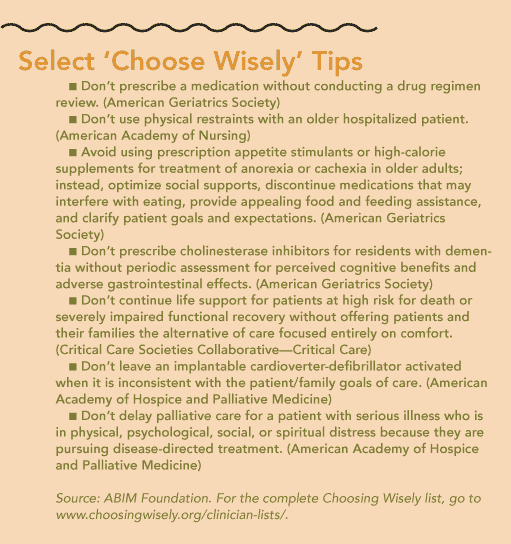AMDA’s List Of Inadvisable Interventions
■ Don’t insert percutaneous feeding tubes in individuals with advanced dementia. Instead, offer oral assisted feeding.
Strong evidence exists that artificial nutrition doesn’t prolong life or improve quality of life in patients with advanced dementia. Substantial functional decline and recurrent progressive medical illnesses may indicate that a patient who isn’t eating is unlikely to get a significant or long-term benefit from artificial nutrition.
■ Don’t use sliding scale insulin (SSI) for long-term diabetes management for individuals residing in the nursing home. SSI is a reactive way of treating hyperglycemia after it has occurred rather than preventing it. Good evidence exists that SSI isn’t effective in meeting the body’s insulin needs or efficient in the long term care setting.
■ Don’t obtain a urine culture unless there are clear signs and symptoms that localize to the urinary tract. Chronic asymptomatic bacteriuria is common in this care setting, with prevalence as high as 50 percent. A positive urine culture in the absence of localized urinary tract infection symptoms such as dysuria, frequency, or urgency is of limited value in identifying whether a patient’s symptoms are caused by a urinary tract infection (UTI).
Colonization is a common problem in long term care facilities and contributes to the overuse of antibiotic therapy in this setting, leading to an increased risk of diarrhea, resistant organisms, and C. difficile infection.
■ Don’t prescribe antipsychotic medications for behavioral and psychological symptoms of dementia in individuals with dementia without an assessment for an underlying cause of the behavior. Careful differentiation of symptom causes may help better define appropriate treatment options. The therapeutic goal of antipsychotic use is to treat patients who present an imminent threat of harm to self or others or who are in extreme distress—not to treat nonspecific agitation or other forms of lesser distress.
■ Don’t routinely prescribe lipid-lowering medications in individuals with a limited life expectancy. There is no evidence that hypercholesterolemia, or low HDL-C, is an important risk factor for all-cause mortality, coronary heart disease mortality, or hospitalization for myocardial infarction or unstable angina in persons older than 70 years.
In fact, studies show that elderly patients with the lowest cholesterol have the highest mortality after adjusting other risk factors.

In addition, a less favorable risk-benefit ratio may be seen for patients older than 85, where benefits may be more diminished and risks from statin drugs increased.
■ Don’t place an indwelling urinary catheter to manage urinary incontinence. The most common source of bacteremia in the post-acute and long term care setting is the bladder when an indwelling urinary catheter is in use.
The federal Health Care Infection Control Practices Advisory Committee recommends minimizing urinary catheter use and duration of use in all patients, as well as not using a catheter to manage urinary incontinence in this setting.
■ Don’t recommend screening for breast, colorectal, or prostate cancer if life expectancy is estimated to be less than 10 years. Although research evaluating the impact of screening for breast, colorectal, and prostate cancer in older adults in general and long term care residents in particular is scant, available studies suggest that multimorbidity and advancing age significantly alter the risk-benefit ratio.
Preventive cancer screenings have both immediate and longer term risks (procedural and psychological risks, false positives, identification of cancer that may be clinically insignificant, treatment-related morbidity, and mortality).
Benefits of cancer screening occur only after a lag time of 10 years or more. Patients with a life expectancy shorter than this lag time are less likely to benefit from screening.
■ Don’t obtain a C. difficile toxin test to confirm “cure” if symptoms have resolved. Studies show that up to 57 percent of patients in the long term/post-acute care setting are asymptomatic carriers of C. difficile and that C. diff tests may remain positive for as long as 30 days after symptoms have resolved. False positive “test-of-cure” specimens may complicate clinical care and result in additional courses of inappropriate treatment.
■ Don’t recommend aggressive or hospital-level care for a frail elder without a clear understanding of the individual’s goal of care and the possible benefits and burdens.
To avoid unnecessary hospitalizations, care providers should engage in advance care planning by defining goals of care for the patient and discussing the risks and benefits of various interventions, including hospitalization, in the context of prognosis, preferences, indications, and the balance of risks and benefits.
■ Don’t initiate antihypertensive treatment in individuals >60 years of age for systolic blood pressure (SBP) <150 mmHg or diastolic blood pressure (DBP) <90 mmHg. There is strong evidence for the treatment of hypertension in older adults.
Achieving a goal SBP of 150 mmHg reduces stroke incidence, all-cause mortality, and heart failure. Target SBP and DBP levels should be set cautiously, however, as data do not suggest a benefit in treating more aggressively to a goal SBP of <140 mmHg in the general population ≥60 years of age.
Furthermore, moderate- or high-intensity treatment of hypertension has been associated with an increased risk of serious fall injury in older adults.
Source: AMDA—The Society for Post-Acute and Long Term Care Medicine. See full descriptions and references for each item at www.amda.com/tools/choosingwisely.cfm.